S.C. Skillman's Blog, page 4
March 20, 2024
QUESTIONS AND ANSWERS Part Three: What Books Did You Love Reading as a Child? What Made You Want to be a Writer? What Authors Have Influenced You?
 A grid of SC Skillman’s favourite children’s books: ‘Pippi Longstocking’ by Astrid Lindgren; ‘The 101 Dalmations’ by Dodie Smith; ‘The Phantom Tollbooth’ by Norton Juster; ‘Heidi’ by Joann Spyri; ‘A Little Princess’ by Frances Hodgson Burnett; and ‘Anne of Green Gables’ by L.M Montgomery
A grid of SC Skillman’s favourite children’s books: ‘Pippi Longstocking’ by Astrid Lindgren; ‘The 101 Dalmations’ by Dodie Smith; ‘The Phantom Tollbooth’ by Norton Juster; ‘Heidi’ by Joann Spyri; ‘A Little Princess’ by Frances Hodgson Burnett; and ‘Anne of Green Gables’ by L.M MontgomeryMy earliest choices included the stories of Mary Plain by Gwynedd Rae – a little bear born in the Bearpit at Berne in Switzerland who is found and adopted by a man she calls The Owl Man because of the glasses he wears, and she is taken by him on a journey including a stay in a hotel where she also meets The Fur Coat Lady.
Other favourite books in my childhood were Astrid Lindgren’s Pippi Longstocking, Dodie Smith’s The Hundred and One Dalmatians, Norton Juster’s The Phantom Tollbooth and Norman Lindsay’s The Magic Pudding, an Australian children’s story, as well as Jerome K. Jerome’s Three Men in a Boat. All of these books I thought witty, brilliant and imaginative.
 Book cover for Enid Blyton’s children’s novel: ‘The Famous Five’
Book cover for Enid Blyton’s children’s novel: ‘The Famous Five’The adventure stories of Enid Blyton were among my top favourites too. So many authors have mentioned Enid Blyton when asked what made them want to become writers. I even believe you can tell the personal characteristics of that author from their favourite member of The Famous Five. My favourite member of the five was George! She was rebellious, she hated being thought of as a submissive girl, and she wanted to be as adventurous, intrepid and risk-taking as any boy.
And certain beloved books I read over and over again: Prince Caspian by C.S. Lewis, Heidi by Joanna Spyri, The Little Princess and The Secret Garden by Frances Hodgson Burnett, Anne of Green Gables by L.M. Montgomery, What Katy Did and What Katy Did at School by Susan Coolidge.
Among the most thrilling books I’ve ever read is King Solomon’s Mines by Rider Haggard. I also enjoyed the books of Monica Dickens: e. g. My Turn to Make the Tea and the stories of how she tried her hand at a career in nursing and a career as a new reporter. Again I found her a very funny writer, and one who described her experiences in ways I could identify with.
In addition poetry was very important to me, especially the poems of Walter De La Mare and narrative poems like The Highwayman by Alfred Noyes and The Ancient Mariner by Samuel Taylor Coleridge. I have long loved Shakespeare’s sonnets and plays, especially A Midsummer Night’s Dream. Later I discovered the Liverpool Poets – Roger McGough, Brian Patten and Adrian Henri. I admired their poetry in print and at public readings.
What made you want to be a writer?My answer to that, as I’ve said above is: when I was a child I read Enid Blyton, and her fiction inspired me to write children’s adventures stories like her. I wrote many, but none ever made it to publication. I particularly enjoyed the Famous Five books and also The Castle of Adventure and The Island of Adventure. I loved stories in which the children outwitted nefarious adults. And George was my favourite, closely followed by Timothy the dog!
The love of writing that Enid Blyton first instilled into me has never left me, but only strengthened over the years. If I’m in the audience at a workshop or conference or public talks I’ll always have my notebook with me, and am apparently writing down everything that’s said, but in reality recording all the names of the other people on the workshop together with whatever personal snippets of information they share about themselves.
Which authors have influenced you? A selection of SC Skillman’s favourite authors: Charlotte Bronte; Jane Austen; Wilkie Collins; Thomas Hardy; JK Rowling; JRR Tolkien
A selection of SC Skillman’s favourite authors: Charlotte Bronte; Jane Austen; Wilkie Collins; Thomas Hardy; JK Rowling; JRR TolkienI have loved many books in my life, but the ones that stand out for me all seem to have three ingredients: archetypal themes, emotional charge and X factor.
Some have the power to shock and electrify the reader: authors such as Joseph Conrad, Graham Greene and Shusaku Endo. Others have characters that haunt you through the years: Jane Eyre and Mr Rochester, Cathy and Heathcliffe, Lizzy Bennett and Darcy, Pip and Estella; perhaps Bathsheba from Thomas Hardy’s Far From the Madding Crowd or Raskolnikov in Dostoyevsky’s Crime and Punishment, or Oscar Wilde’s Dorian Gray; or the master-criminal Count Fosco in Wilkie Collins’ The Woman in White, or maybe Dorothea in George Eliot’s Middlemarch or Nicholas Darrow in Susan Howatch’s Mystical Paths.
And I also favour authors who are witty, perceptive and brilliantly funny – like P.G. Wodehouse, Tom Sharpe, David Lodge, Jerome K. Jerome, Dodie Smith, Stella Gibbons and Jilly Cooper.
I respond to authors whose work shows warmth and compassion, such as Katie Fforde and Joanna Trollope, or those who sail to the furthest reaches of the human psyche, such as Iris Murdoch or Susan Howatch.
And among my most-loved books are those which tell of a small person harnessing the power of loyalty, friendship and love to overcome great odds – JK. Rowling’s Harry Potter stories, JRR Tolkien’s The Lord of the Rings, or C.S. Lewis’s The Lion, the Witch and the Wardrobe. I have marvelled, too, at the imaginative fireworks in Philip Pullman’s His Dark Materials trilogy.
Finally, as a postscript to this, I remember a line from Virginia Woolf’s essay How Should One Read a Book? “I have sometimes dreamt, at least, that when the Day of Judgement dawns…The Almighty will turn to Peter and will say, not without a certain envy when he sees us coming with our books under our arms, ‘Look, these need no reward. We have nothing to give them here. They have loved reading.’”

Hello! My name’s Sheila and I write under the pen name of SC Skillman. I live in Warwick with my husband and son, and my daughter currently lives and works in Australia.
I was born and brought up in Orpington, Kent, and have loved writing most of my life. I studied English Literature at Lancaster University, and my first permanent job was as a production secretary with the BBC. Later I lived for nearly five years in Australia before returning to live and work in the UK.
My output includes psychological, paranormal and mystery fiction, and historical and paranormal nonfiction. Each of my nonfiction books is illustrated by 100 original full colour photos, mostly taken by myself, and others by my son and daughter (both talented photographers!)
In March 2023 I was the Nonfiction Adjudicator at the Scottish Association of Writers Annual Conference in Glasgow. I’m a member of the Society of Authors and the Association of Christian Writers.
My nonfiction books on Warwickshire are published by Amberley and include Paranormal Warwickshire, Illustrated Tales of Warwickshire and A-Z of Warwick. I’m now researching a fourth book for Amberley: Paranormal Gloucestershire. I also have a new contemporary fantasy novel in progress called Director’s Cut.
In addition to my published books, I blog weekly on scskillman.com about books and films I love, people and places of inspiration, life, spirituality, history and travel.
I’m also a public speaker and have spoken to many groups and organisations about Paranormal Warwickshire, Illustrated Tales of Warwickshire, the quirky tales of Warwick, the art of writing creative nonfiction, and the power of story. Do get in touch with me if you’d like a speaker for your group!
Why not sign up to join me on my writing journey?You’ll receive my newsletter straight to your inbox every month. I share gems and snippets from my research discoveries, news and insights from the publishing and writing worlds, plus you’ll be the first to know when I have a new book coming out.
I’d love to have you join us! You can sign up here and you’ll receive a free ebook: Pursuing Your Creative Passion, a taster from my inspiration ebook Perilous Path.
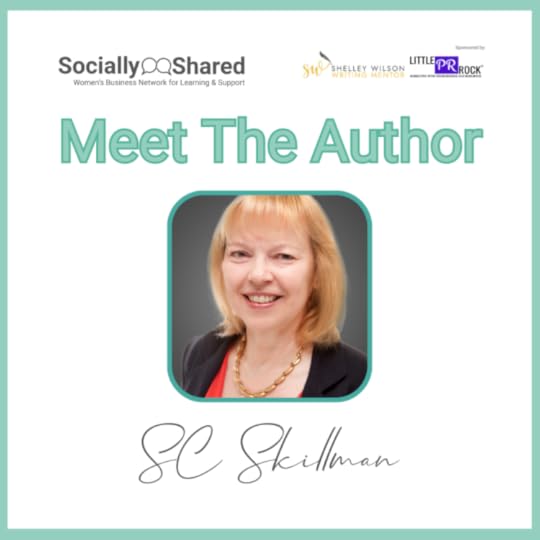
March 7, 2024
Author Research – Gems in Paranormal Gloucestershire
Author research in Gloucestershire for me means a photography trip as well, in order to gather the best images to go with my stories. This is for my forthcoming nonfiction book ‘Paranormal Gloucestershire‘ which is to be published by Amberley and which I will deliver to the publishers before October 2024, for publication in 2025.
On the way I find unexpected delights which have nothing to do with ghosts – and I include pictures of them, for they are places ‘haunted by beauty’.
Here, then, is a foretaste of some of the photos that will be in the book. They are, from top to bottom and left to right,
GLOUCESTER: Dick Whittington’s; the Cathedral; The New Inn
ARLINGHAM: Slowwe House
ST BRIAVEL’S: St Briavel’s Castle
NEWNHAM: the River Severn
LITTLEDEAN: Littledean Hall, Littledean Jail Museum
GLOUCESTER: the Old Prison; The Fleece; and Blackfriars.














 Views of Gloucestershire – Gloucester, Arlingham, Littledean, the River Severn at Newnham, and St Briavel’s Castle. All photos, copyright SC Skillman.
Views of Gloucestershire – Gloucester, Arlingham, Littledean, the River Severn at Newnham, and St Briavel’s Castle. All photos, copyright SC Skillman.


Do join me on my writing journey and sign up to receive my monthly newsletter straight to your inbox. I share gems and snippets from my research discoveries and news and insights from the writing and publishing worlds, plus you’ll be the first to know when I have a new book coming out.
AUTHO BIO
Hello! My name’s Sheila and I write under the pen name of SC Skillman. I live in Warwick with my husband and son, and my daughter currently lives and works in Australia.
I was born and brought up in Orpington, Kent, and have loved writing most of my life. I studied English Literature at Lancaster University, and my first permanent job was as a production secretary with the BBC. Later I lived for nearly five years in Australia before returning to live and work in the UK.
My output includes psychological, paranormal and mystery fiction, and historical and paranormal nonfiction. Each of my nonfiction books is illustrated by 100 original full colour photos, mostly taken by myself, and others by my son and daughter (both talented photographers!)
In March 2023 I was the Nonfiction Adjudicator at the Scottish Association of Writers Annual Conference in Glasgow. I’m a member of the Society of Authors and the Association of Christian Writers.
My nonfiction books on Warwickshire are published by Amberley and include Paranormal Warwickshire, Illustrated Tales of Warwickshire and A-Z of Warwick. I’m now researching a fourth book for Amberley: Paranormal Gloucestershire. I also have a new light gothic horror novel in progress.
In addition to my published books, I blog weekly on scskillman.com about books and films I love, people and places of inspiration, life, spirituality, history and travel.
I’m also a public speaker and have spoken to many groups and organisations about Paranormal Warwickshire, Illustrated Tales of Warwickshire, the quirky tales of Warwick, the art of writing nonfiction, and the power of story. Do get in touch with me if you’d like a speaker for your group!

February 29, 2024
QUESTIONS AND ANSWERS Part Two: What is Your Earliest Memory? – The Tale of a Much Loved Family Pet
What is your earliest memory?
A car journey when I was four years old. I grew up in Orpington, Kent, and our family were driving back home after a visit to pedigree poodle breeding kennels near Tunbridge Wells. We had bought a miniature poodle pup.
 A miniature grey poodle
A miniature grey poodleWe called him “Kimmings”. He was officially a silver poodle, but when very young he was black. I have a vivid memory of sitting behind the front passenger seat craning my neck in excitement to look at my mother in front, with this tiny bundle of black wool on her lap – our new puppy. I was fascinated by him and couldn’t take my eyes off him.
Any other outstanding memories?
Yes, Kimmings went on to live for fifteen years as our much-loved family pet. He was an eccentric character. In fact, he was a Poodle with Attitude. He gave us many years of fun and amusement and shock (including the occasion when he chased the deer herd at Knole Park, Sevenoaks, and nearly got shot).
My mother, Gladys L Skillman, (nee Pastorelli) who was a talented artist, made a model of Kimmings, and I have it today. Here it is:
 Ceramic model of miniature silver poodle by Gladys L Skillman. In the possession of SC Skillman Author.
Ceramic model of miniature silver poodle by Gladys L Skillman. In the possession of SC Skillman Author.My mother also painted and drew pictures. Here is one she created, showing Kimmings asleep, which hangs on my wall today:
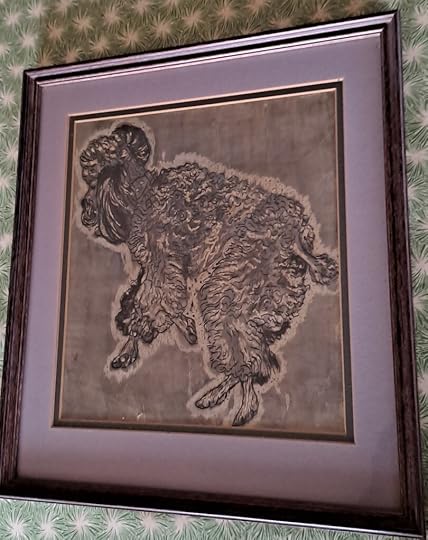 Framed original artwork – miniature silver poodle asleep, by Gladys L Skillman. In the possession of SC Skillman Author.
Framed original artwork – miniature silver poodle asleep, by Gladys L Skillman. In the possession of SC Skillman Author.On one occasion I rescued him from three foot high snow in our local park. On another occasion I practically snatched him out of the jaws of a slavering, snarling Alsation dog, not being properly controlled by his owner. He came on every holiday with us. I have video footage of him:
barking at shadows;
displaying his tea-stained whiskers (he loved to lap up tea from saucers when we served tea out in the garden);
lying exhausted at the top of Snowdon in North Wales;
and standing with his head out of an open car window, enjoying the feeling of his long ears streaming in the wind.
Sad memories – trigger warning for pet lovers!
He was put to sleep by the vet when I was nineteen years old – which is of course, pretty good going for a small dog like a miniature poodle. It didn’t feel like it at the time. I felt as if the bottom had dropped out of my world. Why can’t dogs live for eighty years???
Kimmings had cataracts in both eyes and kidney failure. I was told of his death by my father Ken during the lunch break, where we sat together at the dining table in the family flat above A.D Skillman & Sons, the family business at 108 Woolwich High Street. My mother had taken the decision to carry Kimmings to the vet, to be put to sleep. She felt it was better that way – to make the decision rather than discuss with us all.
So while we had lunch together in the flat above 108 Woolwich High Street, Dad told me that Mum had just rung to give him the sad news – she had taken Kimmings to the vet to be put to sleep.
I was eating at the time, and then I knew what it means for food to “turn to ashes” in your mouth.
Later, I wrote an In Memoriam for Kimmings (which I still have amongst my juvenilia).
NO CATS HERE!!
I also refused to allow his bed to be used by our cat Sukie, and insisted that it be destroyed instead, because it belonged to Kimmings and we would be betraying him if we allowed any other animal to use it.


Why not sign up to receive my monthly newsletter straight to your inbox. I share gems and snippets from my research discoveries, news and insights from the writing and publishing worlds, and you’ll be the first to know when I have a new book coming out. I’d love to have you join us!
Hello! My name’s Sheila and I write under the pen name of SC Skillman. I live in Warwick with my husband and son, and my daughter currently lives and works in Australia.
I was born and brought up in Orpington, Kent, and have loved writing most of my life. I studied English Literature at Lancaster University, and my first permanent job was as a production secretary with the BBC. Later I lived for nearly five years in Australia before returning to live and work in the UK.
My output includes psychological, paranormal and mystery fiction, and historical and paranormal nonfiction. Each of my nonfiction books is illustrated by 100 original full colour photos, mostly taken by myself, and others by my son and daughter (both talented photographers!)
In March 2023 I was the Nonfiction Adjudicator at the Scottish Association of Writers Annual Conference in Glasgow. I’m a member of the Society of Authors and the Association of Christian Writers.
My nonfiction books on Warwickshire are published by Amberley and include Paranormal Warwickshire, Illustrated Tales of Warwickshire and A-Z of Warwick. I’m now researching a fourth book for Amberley: Paranormal Gloucestershire. I also have a new light gothic horror novel in progress.
In addition to my published books, I blog weekly on scskillman.com about books and films I love, people and places of inspiration, life, spirituality, history and travel.
I’m also a public speaker and have spoken to many groups and organisations about Paranormal Warwickshire, Illustrated Tales of Warwickshire, the quirky tales of Warwick, the art of writing nonfiction, and the power of story. Do get in touch with me if you’d like a speaker for your group!
February 22, 2024
QUESTIONS AND ANSWERS Part One: Who put the pop-up in the pop-up toaster?
And the answer is: I did! That was just one of my previous jobs, on the conveyor belt at Morphy Richards factory in my hometown, when I was in my teens. In fact it was first ever paid job and I was thrilled, and when I received my first pay packet I thought I was rich. But read on to find out more.
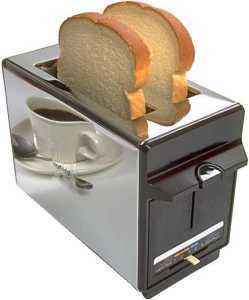 Pop up toaster
Pop up toasterProbably every single job a writer does in life, and every person they ever meet, and every single experience, positive and negative, is raw material for a novel, short story, poem, an article or a nonfiction book… the list goes on and on.
What was the first job you ever had?
At the age of fifteen, I took a school holiday job on the assembly line at the Morphy Richards factory in St Mary Cray, Kent. I was one of the team making pop-up toasters. My job was to put the spring in that actually created the “pop-up”. Despite the fact that I’d passed a dexterity test before getting the job, every so often I lost my grip on the springs and they would ping across the aisle, in through the entrance to the ladies toilets.
The ladies on the assembly line were a revelation to me. I listened avidly to their conversations when the assembly belt stopped at break time and the doughnut trolley came round, and they all started gossiping and chatting, a rich treasure trove for a journal-writer like me.
What are the best and the worst jobs you’ve ever had?
The best was at the BBC, where I worked with lively and witty producers, presenters, broadcasters, scriptwriters, actors, studio managers and all kinds of creative people. I had great fun recording programmes both in studio and on location. I also freely admit that the conversations I heard between actors and producers in the BBC Club Bar at the Langham were a rich resource for me in my subsequent novels.
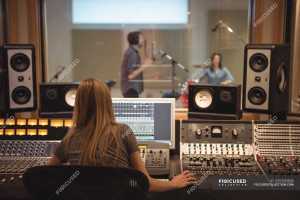 Radio recording studio
Radio recording studioThe worst was a job as a temp at a company called “Imported Meat Trades Ltd” (I’m a vegetarian). After the first day I was asked not to come back again. Not that that was actually the reason for my dismissal. They had no idea what I ate!
 Overwhelmed secretary being bawled out by an impatient boss in an office
Overwhelmed secretary being bawled out by an impatient boss in an office
 Fed-up secretary at her desk in the office
Fed-up secretary at her desk in the officeAs an author of psychological, paranormal and mystery fiction, I draw upon not only my imagination but also my life experience. Write about what you know, they say. Well, I partly agree with that. And I believe a lot of imagination, and often research, is important too! but who knows how your memories, your tastes, your values and personal preferences may play into the created world of your novels? Often the effect they may have upon the imagination of the author lies within the unconscious.
I have worked in admin in the following places:
in London – BBC Schools Radio, the British Council Visitors Department, the Institute of Basic Medical Sciences, Queen Mary College, University of London, and the Church Mission Society.
In Kent – the Chairman’s office at the Kent Messenger, and the European School of Osteopathy.
In Australia – the University of Queensland External Studies, at University of Queensland Press, and the Brisbane City Council.
In Warwickshire – the University of Warwick, the Church Pastoral Aid Society, Mental Health Social Services, Mental Health Assertive Outreach, and the Speech & Language Therapy Department, NHS.
So – far too many to contemplate, and these don’t include all my various temp jobs!
I once had a temp assignment with a company which lost its opportunity to change the course of history – a firm in Tunbridge Wells which supplied ceiling tiles and partitions to the Middle East, and which had supplied and fitted a suspended ceiling to one of Saddam Hussein’s palaces just before the Gulf War. One of the directors said to me, “We should have installed a device up there which emitted a poison gas.” They were subsequently to discover how they might have changed the course of world history over the next two decades.
On another occasion, whilst working as a shop assistant at Swan & Edgar department store in Piccadilly Circus during the Christmas rush, I accidentally threw the till off the counter onto the floor. The impact reverberated around the entire Festive Gifts Department. My line manager, a prototype for Mr Humphries, picked it up and replaced it on the counter with smoothness and panache, and said to me, “Don’t you like this till?” We then carried on serving customers as if nothing had happened.
In this blog series, I will answer some questions I’ve been asked, which include:
What is your earliest memory?
Which books did you love reading as a child?
What made you want to be a writer?
Which authors have influenced you?
What are your favourite things?
How did you get your ideas for your two novels ‘Mystical Circles’ and ‘A Passionate Spirit’?
How long did the two novels take you to write?
What advice would you give someone who wants to be a writer?
These are just some of the questions I’ll be answering in my next few weekly blog posts here on this website at scskillman.com.


Why not join me on my writing journey by signing up to my monthly newsletter. I share gems and snippets from my research discoveries, news and insights from the writing and publishing worlds, and you’ll be the first to know when I have a new book coming out. I’d love to have you join us!
About Me
My name’s Sheila and I write under the pen name of SC Skillman. I live in Warwick with my husband and son, and my daughter currently lives and works in Australia.
I was born and brought up in Orpington, Kent, and have loved writing most of my life. I studied English Literature at Lancaster University, and my first permanent job was as a production secretary with the BBC. Later I lived for nearly five years in Australia before returning to live and work in the UK.
My output includes psychological, paranormal and mystery fiction, and historical and paranormal nonfiction. Each of my nonfiction books is illustrated by 100 original full colour photos, mostly taken by myself, and others by my son and daughter (both talented photographers!)
In March 2023 I was the Nonfiction Adjudicator at the Scottish Association of Writers Annual Conference in Glasgow. I’m a member of the Society of Authors and the Association of Christian Writers.
My nonfiction books on Warwickshire are published by Amberley and include Paranormal Warwickshire, Illustrated Tales of Warwickshire and A-Z of Warwick. I’m now researching a fourth book for Amberley: Paranormal Gloucestershire. I also have a new light gothic horror novel in progress.
In addition to my published books, I blog weekly here on scskillman.com about books and films I love, people and places of inspiration, life, spirituality, history and travel.
I’m also a public speaker and have spoken to many groups and organisations about Paranormal Warwickshire, Illustrated Tales of Warwickshire, the quirky tales of Warwick, the art of writing nonfiction, and the power of story. Do get in touch with me if you’d like a speaker for your group!
Who put the pop-up in the pop-up toaster?
And the answer is: I did! That was just one of my previous jobs, on the conveyor belt at Morphy Richards factory in my hometown, when I was in my teens. In fact it was first ever paid job and I was thrilled, and when I received my first pay packet I thought I was rich. But read on to find out more.
 Pop up toaster
Pop up toasterProbably every single job a writer does in life, and every person they ever meet, and every single experience, positive and negative, is raw material for a novel, short story, poem, an article or a nonfiction book… the list goes on and on.
What was the first job you ever had?
At the age of fifteen, I took a school holiday job on the assembly line at the Morphy Richards factory in St Mary Cray, Kent. I was one of the team making pop-up toasters. My job was to put the spring in that actually created the “pop-up”. Despite the fact that I’d passed a dexterity test before getting the job, every so often I lost my grip on the springs and they would ping across the aisle, in through the entrance to the ladies toilets.
The ladies on the assembly line were a revelation to me. I listened avidly to their conversations when the assembly belt stopped at break time and the doughnut trolley came round, and they all started gossiping and chatting, a rich treasure trove for a journal-writer like me.
What are the best and the worst jobs you’ve ever had?
The best was at the BBC, where I worked with lively and witty producers, presenters, broadcasters, scriptwriters, actors, studio managers and all kinds of creative people. I had great fun recording programmes both in studio and on location. I also freely admit that the conversations I heard between actors and producers in the BBC Club Bar at the Langham were a rich resource for me in my subsequent novels.
 Radio recording studio
Radio recording studioThe worst was a job as a temp at a company called “Imported Meat Trades Ltd” (I’m a vegetarian). After the first day I was asked not to come back again. Not that that was actually the reason for my dismissal. They had no idea what I ate!
 Overwhelmed secretary being bawled out by an impatient boss in an office
Overwhelmed secretary being bawled out by an impatient boss in an office
 Fed-up secretary at her desk in the office
Fed-up secretary at her desk in the officeAs an author of psychological, paranormal and mystery fiction, I draw upon not only my imagination but also my life experience. Write about what you know, they say. Well, I partly agree with that. And I believe a lot of imagination, and often research, is important too! but who knows how your memories, your tastes, your values and personal preferences may play into the created world of your novels? Often the effect they may have upon the imagination of the author lies within the unconscious.
I have worked in admin in the following places:
in London – BBC Schools Radio, the British Council Visitors Department, the Institute of Basic Medical Sciences, Queen Mary College, University of London, and the Church Mission Society.
In Kent – the Chairman’s office at the Kent Messenger, and the European School of Osteopathy.
In Australia – the University of Queensland External Studies, at University of Queensland Press, and the Brisbane City Council.
In Warwickshire – the University of Warwick, the Church Pastoral Aid Society, Mental Health Social Services, Mental Health Assertive Outreach, and the Speech & Language Therapy Department, NHS.
So – far too many to contemplate, and these don’t include all my various temp jobs!
I once had a temp assignment with a company which lost its opportunity to change the course of history – a firm in Tunbridge Wells which supplied ceiling tiles and partitions to the Middle East, and which had supplied and fitted a suspended ceiling to one of Saddam Hussein’s palaces just before the Gulf War. One of the directors said to me, “We should have installed a device up there which emitted a poison gas.” They were subsequently to discover how they might have changed the course of world history over the next two decades.
On another occasion, whilst working as a shop assistant at Swan & Edgar department store in Piccadilly Circus during the Christmas rush, I accidentally threw the till off the counter onto the floor. The impact reverberated around the entire Festive Gifts Department. My line manager, a prototype for Mr Humphries, picked it up and replaced it on the counter with smoothness and panache, and said to me, “Don’t you like this till?” We then carried on serving customers as if nothing had happened.
In this blog series, I will answer some questions I’ve been asked, which include:
What is your earliest memory?
Which books did you love reading as a child?
What made you want to be a writer?
Which authors have influenced you?
What are your favourite things?
How did you get your ideas for your two novels ‘Mystical Circles’ and ‘A Passionate Spirit’?
How long did the two novels take you to write?
What advice would you give someone who wants to be a writer?
These are just some of the questions I’ll be answering in my next few weekly blog posts here on this website at scskillman.com.


Why not join me on my writing journey by signing up to my monthly newsletter. I share gems and snippets from my research discoveries, news and insights from the writing and publishing worlds, and you’ll be the first to know when I have a new book coming out. I’d love to have you join us!
About Me
My name’s Sheila and I write under the pen name of SC Skillman. I live in Warwick with my husband and son, and my daughter currently lives and works in Australia.
I was born and brought up in Orpington, Kent, and have loved writing most of my life. I studied English Literature at Lancaster University, and my first permanent job was as a production secretary with the BBC. Later I lived for nearly five years in Australia before returning to live and work in the UK.
My output includes psychological, paranormal and mystery fiction, and historical and paranormal nonfiction. Each of my nonfiction books is illustrated by 100 original full colour photos, mostly taken by myself, and others by my son and daughter (both talented photographers!)
In March 2023 I was the Nonfiction Adjudicator at the Scottish Association of Writers Annual Conference in Glasgow. I’m a member of the Society of Authors and the Association of Christian Writers.
My nonfiction books on Warwickshire are published by Amberley and include Paranormal Warwickshire, Illustrated Tales of Warwickshire and A-Z of Warwick. I’m now researching a fourth book for Amberley: Paranormal Gloucestershire. I also have a new light gothic horror novel in progress.
In addition to my published books, I blog weekly here on scskillman.com about books and films I love, people and places of inspiration, life, spirituality, history and travel.
I’m also a public speaker and have spoken to many groups and organisations about Paranormal Warwickshire, Illustrated Tales of Warwickshire, the quirky tales of Warwick, the art of writing nonfiction, and the power of story. Do get in touch with me if you’d like a speaker for your group!
February 14, 2024
February 8, 2024
reblog from Comedy Blog ‘The Lower Strangling Chronicles’
February 1, 2024
Review of the RSC’s new 2023 Midsummer Night’s Dream production starring Mat Baynton as Bottom
Today, I’m pleased to be reviewing the latest production at the Royal Shakespeare Theatre, Stratford-upon-Avon. I saw a ‘pre-performance’ in a packed auditorium.
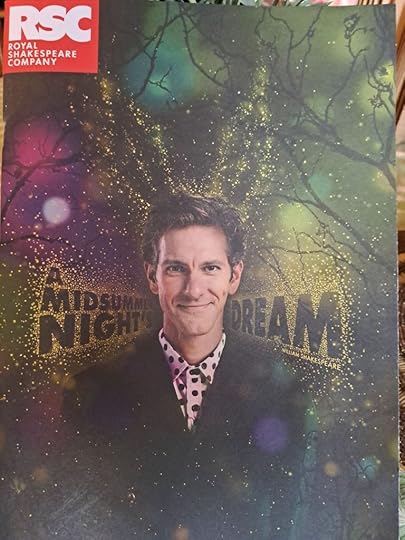 Programme front cover for the 31 January 2023 performance of Shakespeare’s A Midsummer Night’s Dream at the Royal Shakespeare Theatre, Stratford upon Avon.
Programme front cover for the 31 January 2023 performance of Shakespeare’s A Midsummer Night’s Dream at the Royal Shakespeare Theatre, Stratford upon Avon. Mathew Baynton, of course, was the main drawcard for all those who loved him in ‘Horrible Histories’ and ‘Ghosts’! And I must say that here in this RST production, he was able to prove that his legs are worthy rivals to Simon Farnaby’s (as shown in the character of Julian, the disgraced former MP).
As someone who has seen many productions of Shakespeare’s A Midsummer Night’s Dream, I feel able to make comments! I’ve seen all sorts of Pucks trying various interpretations and poses, including standing on top of the stone arch at Hever Castle; a Hermia with a Liverpudlian accent played by one of the Liver Birds in the Regent’s Park Open Air theatre; a gender-switch Oberon & Titania at the National Theatre, a Bottom with a Dudley accent at the RST, and fairies dancing through the Compton Verney woodlands wearing nothing but green paint (and probably wellington boots!). I also remember fairies who looked like local hoodlums running riot at Kenilworth Castle.
In addition, I’ve made much use of the imagery and significance of Shakespeare’s spirits in my author talks, and have quoted from this play in my own books, so I know some of the famous lines off by heart, and remember how I heard actors performing them before, and the effect they had on me. I’ve also, as a choir member, sung the fairies’ song as part of Mendelssohn’s incidental music for A Midsummer Night’s Dream!
This production is an amazing cornucopia of lighting, special effects, video projection, magical sound effects, music, choreography, and illusion. I loved it when Puck flung out her arms and a glow-worm like light appeared on her hand or at the back of the stage.
The actress who played Puck came over as a wild urchin of the forest. Her movements were those of a naughty, jaunty schoolboy. I never quite believed in her supernatural nature – perhaps she could have darted about more in an unpredictable way, whizzing up the stage ladders & hanging there, dangling halfway up by one leg, disrespectful & insouciant.
The essence of Robin Goodfellow or Puck, is that the sprite is amoral – not amoral as humans can be, but only as a faery can be, because they operate by the faery code, not by human values. I enjoyed the way she delivered, ‘Lord! What fools these mortals be!’ whilst lying prone on the stage as if in despair. I had likewise never heard the line ‘I go. I go. See how I go’ delivered in that way before to Oberon – slow sullen, rebellious, sarcastic.
I was a little surprised at the decision not to include Peaseblossom, Moth, Mustard Seed, and Cobweb on stage but instead portray them as blobs of glowing light, with their words as voiceovers.
I loved Oberon, dressed as he was in a style I thought might be a mixture of steam punk and goth with high heels. I particularly enjoyed his patronising instructions to Puck: ‘Go, seek – out – He- le- na…’ very slowly as if Puck was thick! That worked very well. But I felt he missed out on the comic effect of, ‘What – have – you- done?’ to Puck when he sees the mess Puck has created.
Lysander was brilliant, hugely athletic and very funny with his physical comedy.
The four star crossed lovers were full of energy, but the potential of the line ‘Oh, she was a vixen at school!’ was missed, in that I’ve heard it delivered before with much greater emphasis and comic effect.
Mat Baynton as Bottom was also very comical, and his timing was excellent as he sprang forward to be the first of the rude mechanicals to know best and show himself as the ultimate thespian; and he was particularly good at sudden unexpected changes of tone.
So overall, it’s a fabulous production with many highlights, but not one of the very best I’ve ever seen… however, it was only a pre-performance, so perhaps greater surprises are ahead for this production in the next 6 weeks!
If you’ve enjoyed this and my regular posts here on this site, why not add your name to my list of email followers for a monthly update straight to your inbox – to sign up to my mailing list just go here for the sign up page!
About the Author
Sheila lives in Warwickshire, and writes psychological, paranormal and mystery fiction and non-fiction under the pen-name SC Skillman. She is a member of the Society of Authors and the Association of Christian Writers. Her non-fiction books on local history are published by Amberley and include ‘Paranormal Warwickshire,’ ‘Illustrated Tales of Warwickshire’; and ‘A-Z of Warwick’. She is now working on ‘Paranormal Gloucestershire’.
She was born and brought up in Orpington, Kent, and has loved writing most of her life. She studied English Literature at Lancaster University, and her first permanent job was as a production secretary with the BBC. Later she lived for nearly five years in Australia before returning to the UK. She has now settled in Warwick with her husband and son, and her daughter currently lives and works in Australia.
January 10, 2024
Blog Tour for Val Penny’s New Book: ‘Hunter’s Christmas and Other Stories’
I’m delighted to be part of Val Penny’s blog tour for ‘Hunter’s Christmas and other stories’, the latest addition to her Edinburgh crime series.
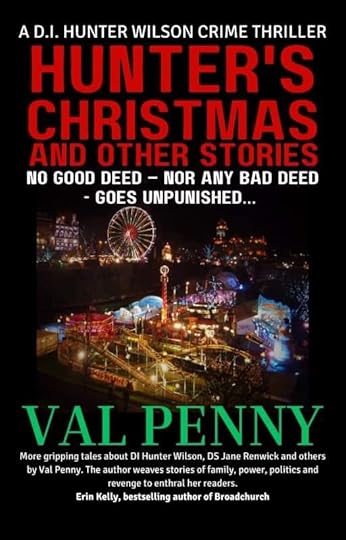 Book cover image of ‘Hunter’s Christmas and other stories’ by Val Penny
Book cover image of ‘Hunter’s Christmas and other stories’ by Val Pennypublished by Spellbound
I’m a keen follower of Hunter’s team as they investigate the activities of the Edinburgh criminal fraternity, having read all the books in the series so far.
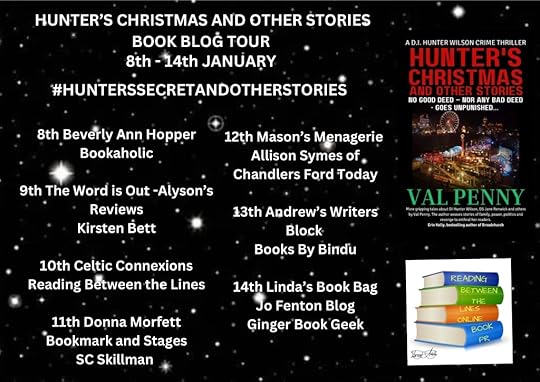
Who knew that beautiful, elegant, fascinating city Edinburgh could be so seamy? Very easily, in the hands of Val Penny! For all the miscreants in the bars, department stores, car parks, off licences and car dealerships are under the eye of DI Hunter Wilson and his highly proactive, doughnut-munching team at Police Scotland! In fact, when I consider the popular genre of Scottish Noir, I wonder whether Police Scotland have a special department dedicated to answering the queries of crime writers researching police procedures for their next book!
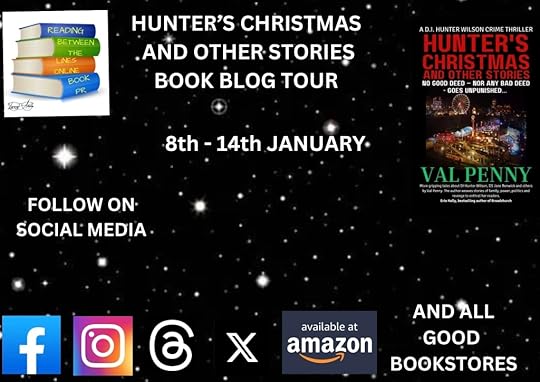
AUTHOR BIOGRAPHY
Val Penny has an Llb degree from the University of Edinburgh and her MSc from Napier University. She has had many jobs including hairdresser, waitress, banker, azalea farmer and lecturer but has not yet achieved either of her childhood dreams of being a ballerina or owning a candy store.
Until those dreams come true, she has turned her hand to writing poetry, short stories,nonfiction books, and novels. Her novels are published by SpellBound Books Ltd.
Val is an American author living in SW Scotland. She has two adult daughters of whom she is justly proud and lives with her husband and their cat.
BLURB
DI Hunter Wilson is looking forward to spending a holiday in India with his girlfriend Dr Meera Sharma, away from the cold, wet winter of Edinburgh. He looks to share his happiness with others when he is attacked by Santa Claus, he says.
His team swing into action to catch his attackers but then receive information about an elf found dead in a car park and a car stolen by Mrs Claus.
Are the crimes by these Christmas characters connected?
Can Hunter’s team restore peace and good will to Christmas?
Hunter’s Christmas and Other Stories includes tales about DI Hunter Wilson and DS Jane Renwick along with those about new and different characters in this gripping collection of short stories especially for crime fiction readers.
LINK TO BUY
WEBSITE AND SOCIAL MEDIA LINKS
Website – https://www.valpenny.com
Amazon Author Page – https://www.amazon.co.uk/Val-Penny/e/B07C4725TK
Author Facebook Page – https://www.facebook.com/valerie.penny.739
Author Twitter Page @valeriepenny
Author Instagram Page https://www.instagram.com/valerieepenny/
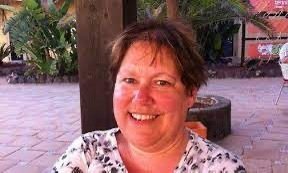 Val Penny, author of the Edinburgh crime fiction series
Val Penny, author of the Edinburgh crime fiction seriesMY REVIEW
#HUNTERSCHRISTMASANDOTHERSTORIES
In ‘Hunter’s Christmas’, the first story in this collection, the team are keen to find the trio of villainous Santas who assaulted DI Hunter at the ATM, the murderer of the Elf found in the car park, and the Mrs Claus who stole the high-end vehicle from Thomson’s Top Cars. All of them need to be identified, apprehended, ushered into the interview room, subjected to questioning alongside the dubious hospitality of the cheap plastic cup of police station tea, found guilty, booked, charged and hauled off to the cells, all before the Christmas festivities start. That is the challenge. How Hunter’s team achieve this makes for a highly paced, entertaining and captivating read – all carried out with Val Penny’s familiar flair for sharp, colourful characterisation.
However, sadly I wasn’t so keen on the other short pieces in this book, except for the final story, when we are back on safe ground again with Hunter and his team in ‘The Second Chance’.
With many of the short stories, though the set-up was interesting, I found the endings very grim without my fully grasping and believing in the characters’ motivation – which, to me, is always a redeeming factor.
With Hunter and his team, and the situations they encounter, humour, a lightness of touch, and warm and engaging characterisation are all at the very heart of Val’s stories.
I look forward to the next full-length novel in the Edinburgh Crime series.


Do sign up to receive my monthly newsletter straight to your inbox, in which I share gems and snippets from my research discoveries, news and insights about the writing and publishing worlds, plus you’ll be the first to know when I have a new book coming out.
December 20, 2023
A Visit to the Newly-Reopened Lord Leycester Hospital in Warwick December 2023
Lord Leycester Hospital is one of the town of Warwick‘s great medieval treasures, formerly a home for the Brethren (injured military heroes of Queen Elizabeth I‘s wars), and the pride and joy of Sir Robert Dudley, Earl of Leycester, from 1571, the time when he first took it over to please Elizabeth.
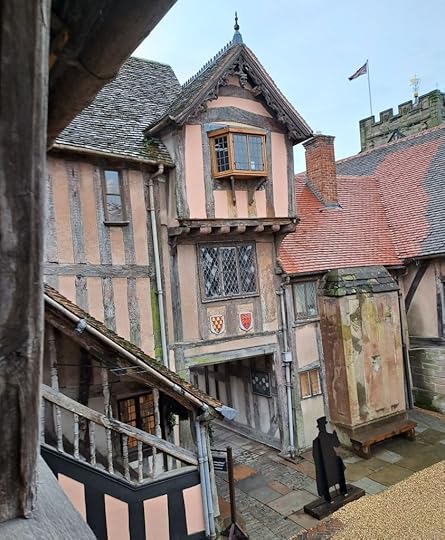
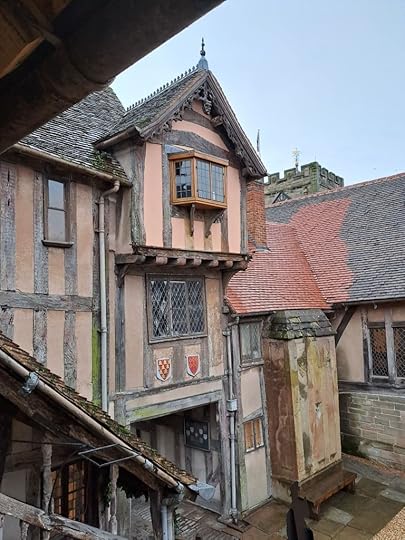
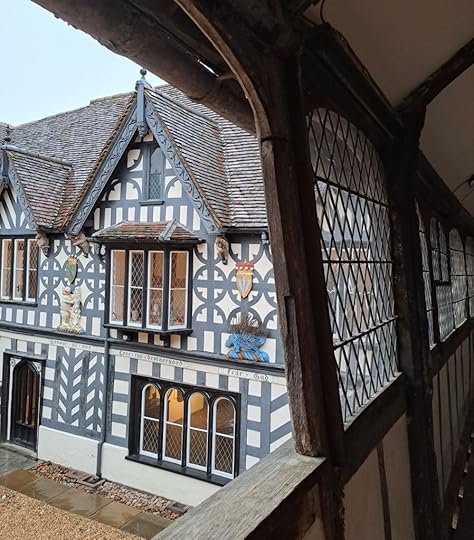

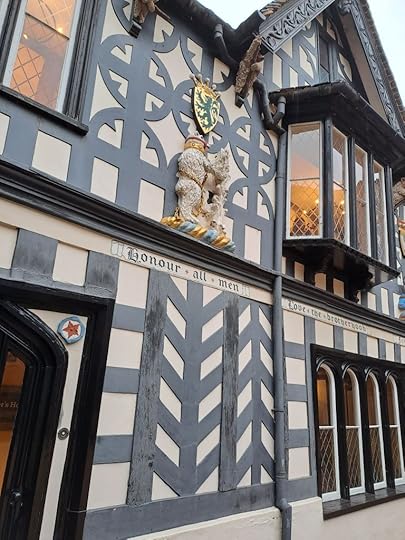
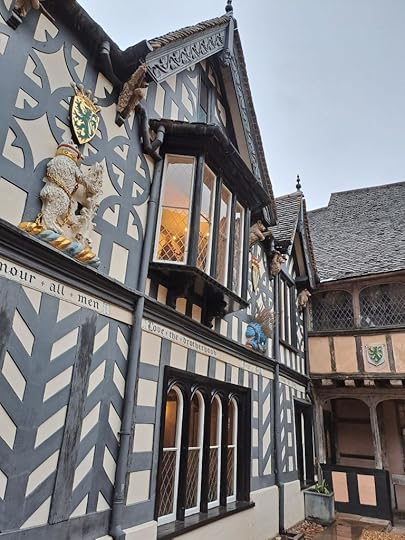

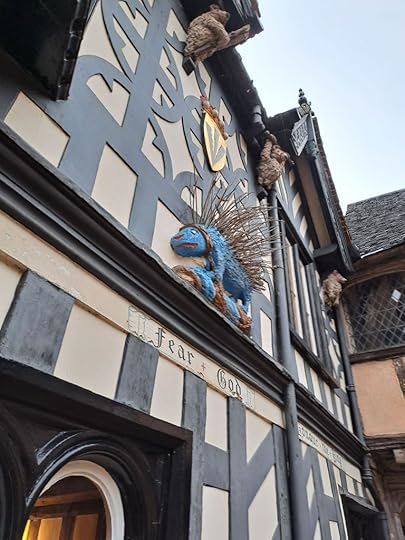
It is now not only a historical vision on Warwick’s high street, adjoining Warwick’s West Gate and medieval wall, but also a hugely popular film location. You will have seen Dr Who and Martha, Mr Darcy, Ebenezer Scrooge, Luella Shakespeare and Frank Hathaway along with Sebastian and a sprinkling of strange clients, all making their way around the precincts and courtyard of the Lord Leycester Hospital. It is one of my favourite places in Warwick, an amazing survival from the 1694 Great Fire of Warwick, and it features in all my three Warwickshire books published by Amberley.
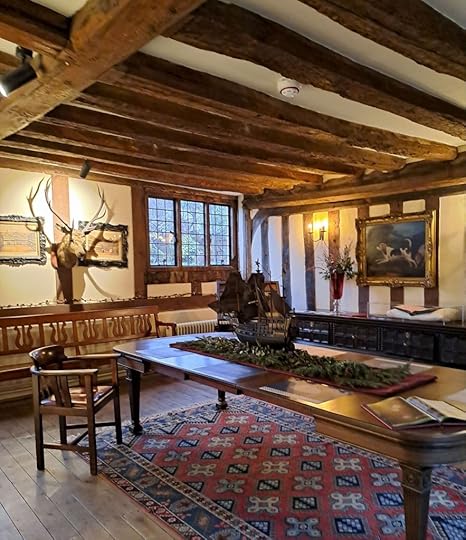
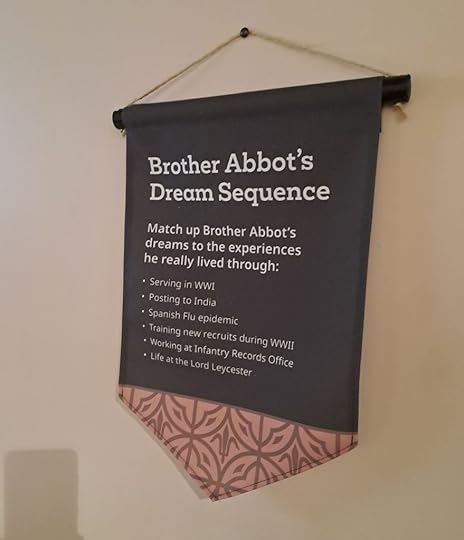


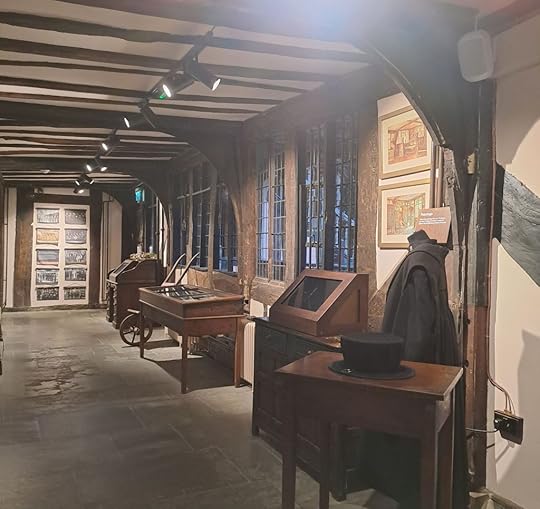

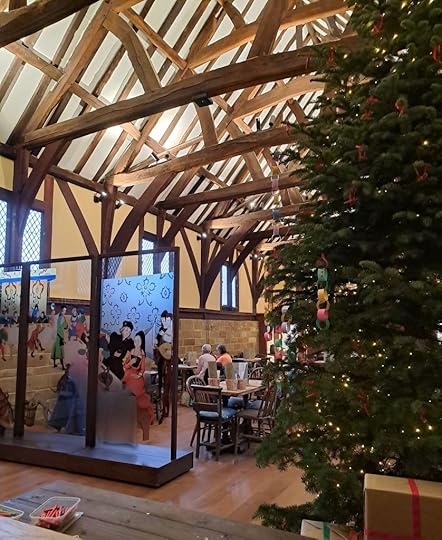
The Lord Leycester Hospital has now been through an extensive programme of changes; rooms hitherto inaccessible to the public have been opened up, and the Brethren’s Kitchen has been restored to its original state as a medieval kitchen:
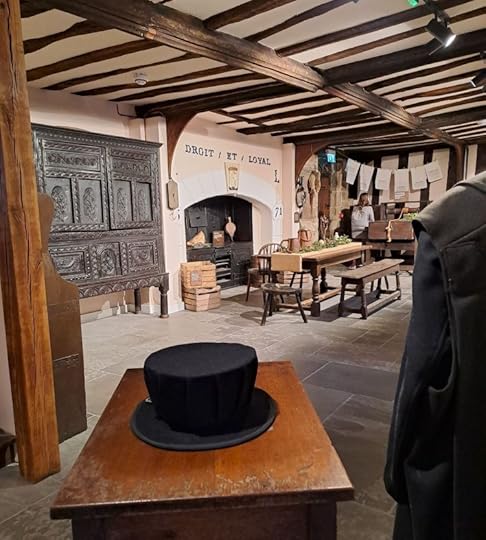
while the cafe has moved to a new location in the Great Hall.

A room in the Master’s House has been opened as a museum:
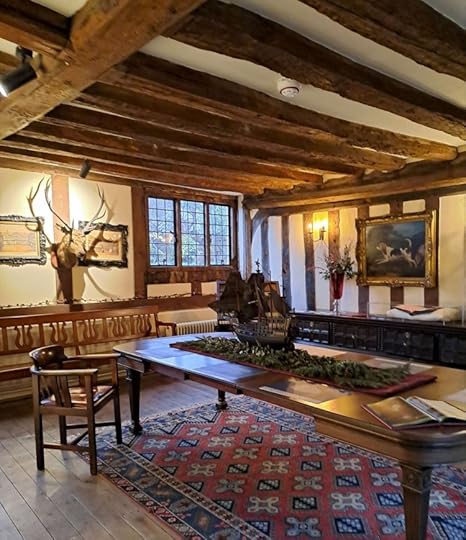
and you may study a wealth of information about the history of Lord Leycester Hospital alongside a timeline of major national events for the last 900 years.
There are also experiential exhibits and videos to enjoy:



So the experience of visiting Lord Leycester Hospital has been transformed.
In the Chapel over the West Gate, you may choose different examples of music from each of six centuries to listen to.
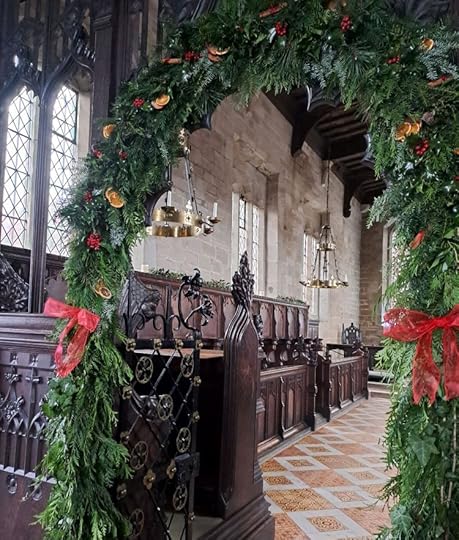
Then, if you make your way through the doorway at the rear of the chapel, you will walk along on top of Warwick’s remaining medieval, wall, to the Master’s Garden.
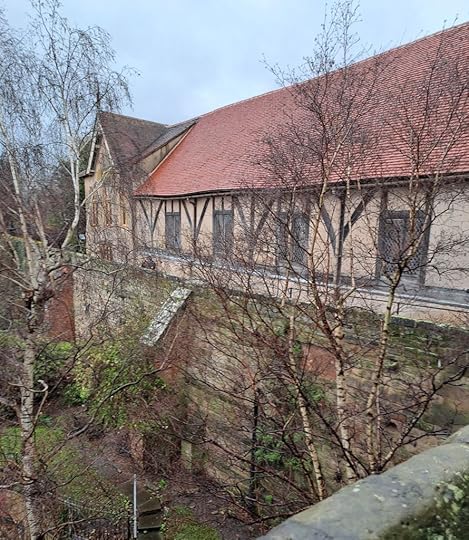
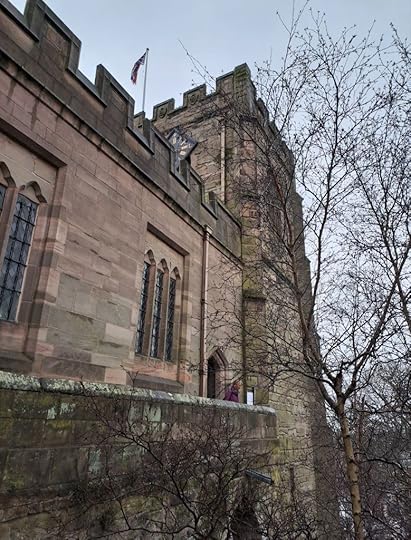

Finally, enjoy the Master’s Garden which still makes a big impact on you even in winter when the branches and flower beds are bare.
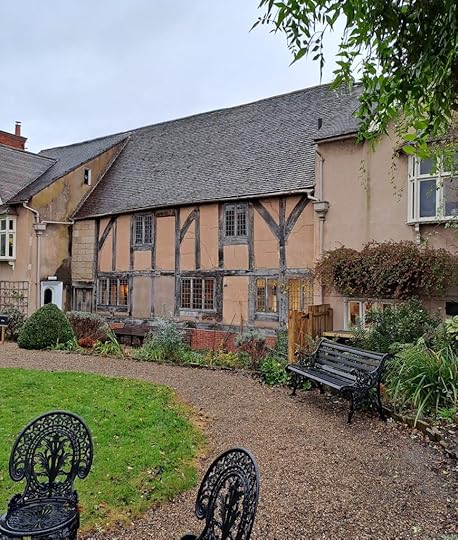
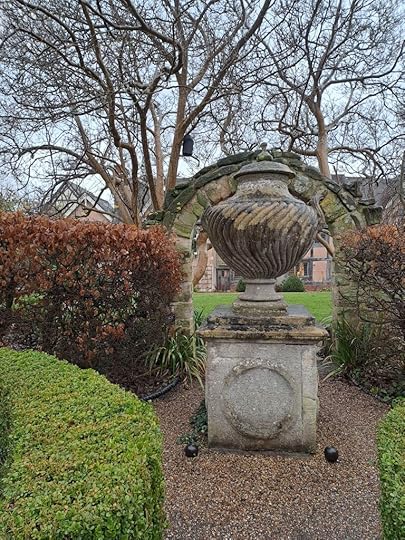


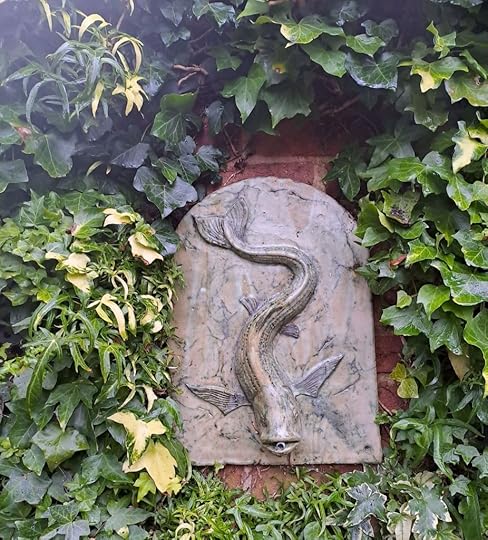

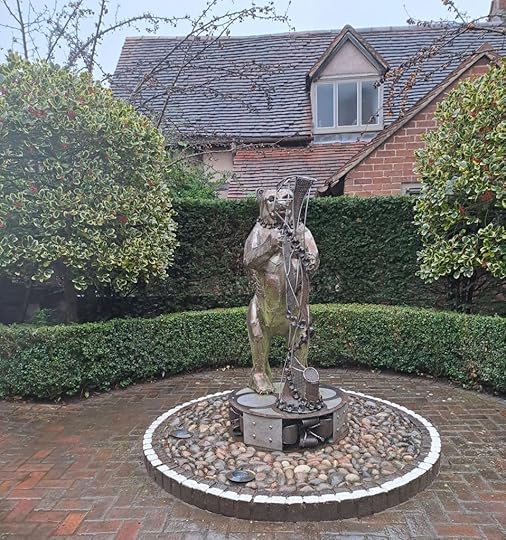

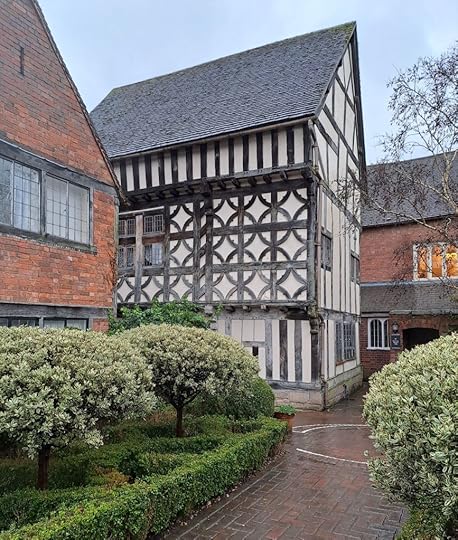


Why not join me on my writing journey and sign up to receive my monthly newsletter straight to your inbox? I share gems and snippets from my research discoveries and news and insights from the worlds of publishing and writing. Plus you’ll be the first to know when I have a new book coming out.
You can also, if you wish, support me here at buy me a coffee and I’d be very grateful.
All photos of the Lord Leycester Hospital on this blog post are taken by Sheila Robinson 0n 19 December 2023.


